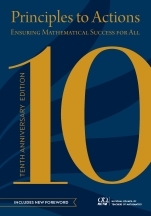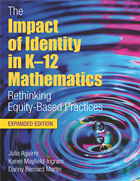Grading
Read more on how to implement these tips:
Focus on student learning, not just product. According to NCTM's position statement, grading should focus on student learning and understanding, rather than just the product or outcome. To rethink your grading practices, try the following:
- Emphasize process over product by grading students on their problem-solving strategies, communication, and critical thinking, rather than just their final answers.
- Use rubrics that evaluate student learning, such as understanding of concepts, application of skills, and persistence in problem-solving.
- Consider using alternative grading systems, such as standards-based grading or competency-based grading, which focus on students demonstrating mastery of specific skills and knowledge.
- Provide diverse forms of feedback, including verbal and visual explanations, to guide students through their learning journey.
- Clearly define what aspects of their work are being evaluated, whether it's their ability to use multiple strategies, show their work, or arrive at the correct answer.
When evaluating student mastery of specific math content, consider using a growth mindset approach, focusing on progress toward mastery rather than absolute mastery. For example, you might use a "three-level rubric" that assesses students as "developing," "approaching," or "mastery" on specific skills or concepts. This approach recognizes that mastery is a continuous process and provides students with clear targets for improvement. By shifting your focus from product to process and emphasizing student learning, you'll be able to provide more meaningful feedback to your students and help them develop a deeper understanding of math concepts.
Use student-centered rubrics. A rubric is a powerful tool for grading, and one that can be used for both project-based assignments with multiple components and for assessing content mastery. By developing a rubric with students, you can create a clear roadmap for understanding what it means to demonstrate mastery on a specific topic or skill. Grading assignments on a 0-4 scale based on a class-developed rubric can be one of the fairest ways to assess student understanding, as it provides a clear and transparent framework for evaluation.
This approach not only helps students understand what's expected of them but also encourages them to take ownership of their learning, as they work towards achieving mastery. By involving students in the rubric development process, you can also help them develop critical thinking, problem-solving, and communication skills – all essential skills for success in any subject area.
Diversify assessment methods. Incorporate various types of assessments into your planning to cater to different learning styles and abilities. Use short quizzes, longer open-note assessments, and task-oriented projects to give students the opportunity to "show what they know." Diversifying assessments can help reduce the stigma associated with traditional testing and promote more inclusive assessment practices. However, be mindful that students will still need to take traditional tests like state exams, SAT/ACT, and AP tests. Therefore, while diversifying assessments, ensure that students are also prepared for these conventional testing formats.
Streamline your grading with technology. Utilize digital tools to automate repetitive grading tasks and reduce the time spent on grading. Consider using educational apps such as IXL, DreamBox, or other digital tools that enable quick and efficient grading of multiple-choice items. These platforms allow teachers to focus on more important aspects of teaching, rather than spending excessive time on grading. Teachers can leverage these digital tools to simplify the grading process. By doing so, you can encourage a shift from "answer getting" to "the process" – focusing on the thought process and understanding behind the answers rather than just the final answer.
Reevaluate the purpose of grading homework. Shift the focus of homework from grading individual assignments to fostering understanding and self-reflection. Instead of collecting and grading every piece of homework, consider reviewing them together as a class or providing answer keys for independent review. This approach encourages accountability and allows students to reflect on their own learning process, supporting the idea that homework should be a tool for practice and growth rather than just assessment. By rethinking homework grading, you create a more supportive and effective learning environment that emphasizes student development.
 Focus on growth and progress. To foster a growth mindset in your math classroom, focus on growth and progress in your grading practices by emphasizing continuous improvement rather than just final outcomes. Use assessment tools that track students' development over time, such as growth-oriented rubrics or feedback systems that highlight areas for improvement. When grading assignments, instead of focusing on mistakes, use positively oriented credit accumulation to acknowledge student progress. For example, use "+2 out of 4 points" rather than "-2 out of 4 points" to encourage students to view challenges as opportunities to learn and improve. Encourage students to reflect on their learning journey and set goals for improvement, fostering a mindset that values effort and learning. By prioritizing growth and progress, you create a supportive environment where students feel motivated to continually improve their mathematical skills and understanding.
Focus on growth and progress. To foster a growth mindset in your math classroom, focus on growth and progress in your grading practices by emphasizing continuous improvement rather than just final outcomes. Use assessment tools that track students' development over time, such as growth-oriented rubrics or feedback systems that highlight areas for improvement. When grading assignments, instead of focusing on mistakes, use positively oriented credit accumulation to acknowledge student progress. For example, use "+2 out of 4 points" rather than "-2 out of 4 points" to encourage students to view challenges as opportunities to learn and improve. Encourage students to reflect on their learning journey and set goals for improvement, fostering a mindset that values effort and learning. By prioritizing growth and progress, you create a supportive environment where students feel motivated to continually improve their mathematical skills and understanding.
Embark on a journey of continuous learning alongside your students! Regularly practice solving math assignments to develop a deeper understanding of the material and to experience the same challenges and triumphs that your students face. As you work through these problems, reflect on your own thought process and strategies, and consider how you can apply this self-reflection to your grading practices. For example, you might use rubrics that assess not only correctness, but also the process and reasoning behind the student's work, mirroring the way you're developing your own problem-solving skills. By acknowledging and celebrating your own growth and progress, you'll be modeling a growth mindset for your students and empowering them to do the same. As you strive to improve your own math skills, you'll be better equipped to
provide constructive feedback that supports their learning journey, creating a collaborative and motivating learning environment.
Avoid punishing effort with zeroes. Instead, adopt a growth-oriented approach to grading that focuses on the learning process rather than the assignment itself. Be mindful of "indiscriminate zeroes" that can unfairly penalize students for incomplete or late work, and instead consider providing opportunities for students to make up missed assignments or reducing the weight of the assignment in the overall grade. This approach helps to promote a sense of responsibility and encourages students to take ownership of their learning.
Consider moving to a more standards-based grading mindset, where the focus is on measuring students' mastery of specific skills or concepts rather than completing a particular assignment. When a student demonstrates mastery of the intended learning objective, they earn credit, regardless of whether it's through a traditional assignment or an alternative method. By shifting your focus from the assignment to the learning, you'll be able to provide more targeted feedback and support, helping students grow and succeed without unnecessary penalties.
Related Publications:

